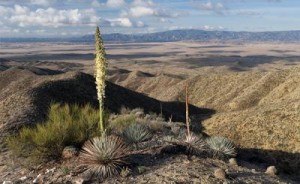The Carrizo Plains is home to thirteen different species listed as endangered either by the state or federal government, one of the largest concentrations of endangered species in California. Some of these species include the San Joaquin kit fox, the San Joaquin antelope squirrel, the blunt-nosed leopard lizard, the giant kangaroo rat, greater and lesser sandhill cranes, and the California condor. The Tule elk, pronghorn, black-tailed jackrabbit, western coyotes, and Le Conte's Thrasher all also make their homes in the Carrizo plains.
- San Joaquin kit fox — a small nocturnal subspecies of the Kit Fox that was formerly common throughout the San Joaquin Valley but has recently become endangered.
- blunt-nosed leopard lizard — a small, 3-5 inch gray to brown lizard with large dark spots and cream-colored cross bands. It has a broad, triangular shaped head and is endemic to California. It inhabits the grasslands and alkali flats of the San Joaquin Valley and the surrounding foothills and valleys.
- giant kangaroo rat — the largest of all kangaroo rats. The giant kangaroo rat is also endemic to California and now only occupies about 2% of its original range, making it critically endangered.
- San Joaquin antelope squirrel — a light tan squirrel with a white belly and a white stripe down its back and sides. Most of its habitat is used for agriculture, making the Carrizo Plains the habitat for most of the remaining population.
The regions of the Carrizo Plain:
Soda Lake:
 Soda Lake is the largest remaining natural alkali wetland in California. The proposed wilderness area would include 13,332 acres. The lake is part of the only closed watershed within the Southern California coastal mountain ranges and boasts a unique clay dune system. The stark white lakebed can be seen from miles around. The area supports rare plant species including Jared's pepper grass, Munz's tidy tips, and valley larkspur. Four endangered animal species make their homes here as well, including the blunt-nosed leopard lizard, San Joaquin kit fox, giant kangaroo rat, and San Joaquin antelope squirrel.
Soda Lake is the largest remaining natural alkali wetland in California. The proposed wilderness area would include 13,332 acres. The lake is part of the only closed watershed within the Southern California coastal mountain ranges and boasts a unique clay dune system. The stark white lakebed can be seen from miles around. The area supports rare plant species including Jared's pepper grass, Munz's tidy tips, and valley larkspur. Four endangered animal species make their homes here as well, including the blunt-nosed leopard lizard, San Joaquin kit fox, giant kangaroo rat, and San Joaquin antelope squirrel.
Temblor Mountains:
The Temblors contain a diverse mix of native grasses and perennial shrubs known as the Upper Sonoran subshrub community. The 12,585 acre proposed wilderness area over a dozen native plant species including the endangered purple California jewelflower and yellow San Joaquin woollythreads can be found as well as rare orange forked fiddleneck. Groves of blue oaks and valley oaks occur in the north, while Tucker oak populates the middle and south parts of the range. The Temblors were formed from the uplifting of the San Andreas Fault, resulting in steep valleys and ridges. The endangered giant kangaroo rat and San Joaquin antelope squirrel also live in the Temblor Mountains.
Caliente Mountains:
The Calientes are rugged country with sandstone outcroppings and ancient Juniper trees, Manzanita, Scrub oaks, and other shrubs. The 17,870 acre potential wilderness area includes the highest peak in San Luis Obispo County at 5,104 feet. Numerous species of wildlife make their home in the mountains and along its flanks including Tule elk, wild pigs, mountain lions, deer, and coyotes. The lower elevations house the endangered San Joaquin kit fox and blunt-nosed leopard lizard. A tiny endangered flower species called Hoover’s eriastrum exists here, along with rare oval-leaved snapdragons and heartleaf thorn mint.
Total Size of wilderness additions- 43,787 acres







